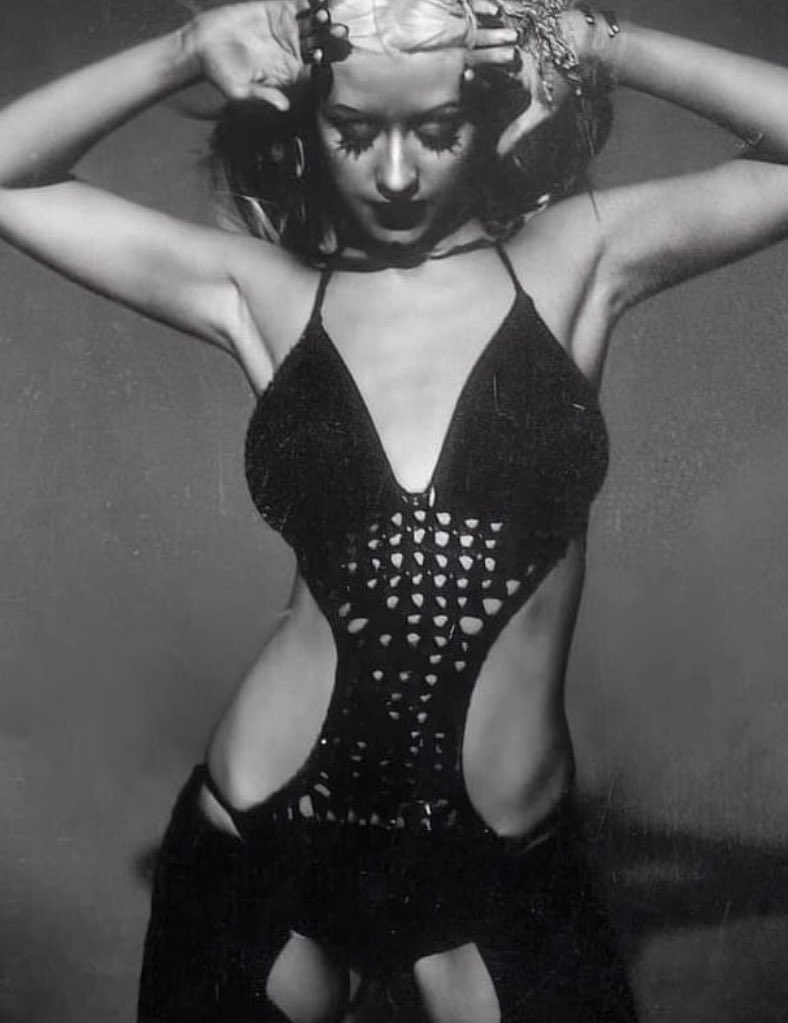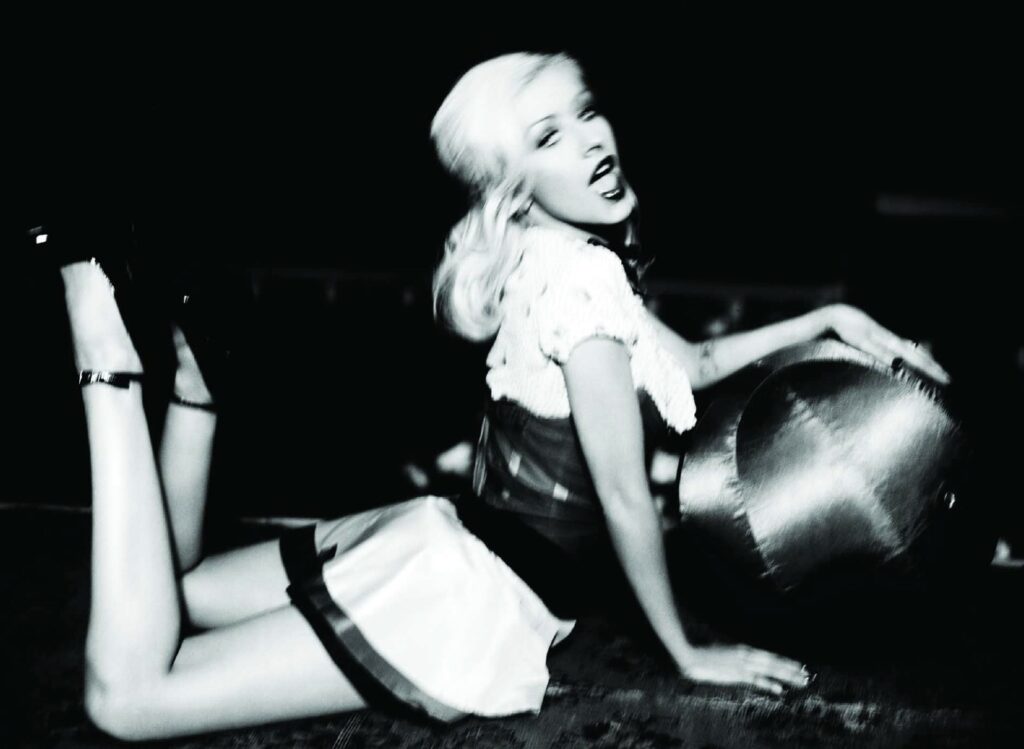
Photo courtesy of RCA Records. (2006)
Eternally awe-inspiring and growing more and more popular in retrospect with each passing day, the 1990s will forever seem to fascinate. And one of its most fascinating aspects was, without a doubt, its music. From 1991 to 1995, the United States of America would see a near dizzying influx of iconoclasts and superstars either debut or go on to solidify their strongholds across a smorgasbord of genres, both mainstream, and sub. But regardless of the commercial dominance and musical prowess that the adults would show in the first half of the decade, the years 1996 through 1999 would belong firmly and ferociously to the youth. In just two years, radio and record stores around the country would find themselves battling wave after wave of allowance-baring teens, tweens and tots clamoring to get their hands on the latest CD, cassette, or cassingle adorned with their pint-sized pop-star of choice’s exceedingly fresh face. And those potential choices were unlimited.
After making her breakthrough with Jive Records via 1994’s Age Ain’t Nothing But A Number, high school senior Aaliyah Haughton would join forces with Atlantic Records and unleash 1996’s R&B tour de force One In A Million. In 1997, Country dynamo Leann Rimes, then 15, would make Billboard chart history with her rendition of the Dianne Warren penned “How Do I Live,” which would ultimately stay on the Hot 100 for a staggering 69 weeks. 1998 saw the boys (and boy-bands) strike back with the arrivals of *NSYNC (home to James “Lance” Bass, then 19, and Justin Timberlake, then 17), the Backstreet Boys (whose role of heartthrob belonged squarely to 18-year-old Nick Carter) and a globe-trotting pre-pubescent Aaron Carter, who would turn 11 that December. But late 1999 would send shockwaves throughout the adolescent atmosphere when it brought the economically booming teen media movement its crowning jewel in the form of Wexford, PA wonder-kid Christina Maria Aguilera.

Photo courtesy of RCA Records. (1999)
From the very first note, Aguilera’s formal introduction, August 1999’s self-titled LP, captivated both wide-eyed and seasoned audiences alike. Skyrocketing to the #1 position on the Billboard Top 200 Albums chart and garnering unusually fierce critical acclaim, Christina Aguilera shot the 5’2” phenomenon to superstardom in a mere matter of months. By the end of 2000, Aguilera’s sugary-sweet visage had graced everything from keychains, posters, books, backpacks, and dolls to magnets, beach towels, bandanas, and packs of bubble gum. Needless to say, Aguilera’s label RCA Records, which had been experiencing severe financial difficulties prior to the album’s release, was thoroughly enthused. Still, one crucial piece of the Pop puzzle had little to be elated about: Christina herself. In public, 19-year-old Aguilera was the pin-up-ready picture of late ’90s and early ’00s perfection. But in private, Aguilera wasn’t on top of the world at all; by all close accounts, she was concretely in the notoriously unforgiving eye of the industry storm. Though the LP was a juggernaut and Aguilera’s performances therein were considerably stellar, what would transpire during the LP’s recording and its aftermath were inarguably less than wholesome.
A lifelong lover of Jazz, Rap, R&B, and Blues, Aguilera was reportedly stifled by the album’s Pop-oriented and label-appointed producers from the outset. Not only were Aguilera’s potential non-vocal offerings largely axed or obscured, but Aguilera’s choice of potential collaborators were also disregarded for fear of the record becoming “too urban.”
In addition to a lack of creative control, the juvenile Aguilera’s management team also purportedly mishandled her money and scheduling, leading to the budding starlet being coerced into recording two further albums and completing a grueling cross-continental tour simultaneously, inevitably wreaking havoc on the health of her and her crew. Out of other options, Aguilera would file a lawsuit against manager Steven Kurtz in the Fall of 2000, finally freeing her to step into her own, musically, personally, and professionally.

Photo courtesy of RCA Records. (1999)
And step, she certainly did. Stripped, Aguilera’s fourth record on RCA ranked among 2002’s most intelligent and successful outings and among its most controversial, too. Aguilera, invigorated by her newfound independence (and dually inspired by decades of internal strife), took on the moniker Xtina and waged artistic war on the constraints placed on her by her former team and the patriarchal beliefs that emboldened them. Tackling once taboo subjects such as casual sex, infidelity, misogyny, feminism, and domestic violence, Stripped laid fully bare what had been on the introspective ex-ingenue’s heart and mind for quite some time. Most noteworthy of all, though, Stripped would signal to the business and the world that the sanguine songbird had found a harmonic home for her to thrive in: Blue-eyed-soul. Stripped‘s blockbuster status led to a multitude of accomplishments and changes in Aguilera’s life from 2002-2004, including recognition for her songwriting, the ability to work alongside the urban talent that she pleased, and a second sold-out global arena tour (though this time the trek wouldn’t cause Aguilera bodily harm).
On top of those key shifts in her career, the Stripped era would present yet another gift upon the singer’s figurative shelf: a whirlwind romance. Tying the knot in 2005, Aguilera and her beau Jordan Bratman were said to have been a match made in heaven, and she would go on to express her wedded bliss in the best way she knew how: through music. Released on August 15th, 2006, Back To Basics, Christina’s fifth album under RCA Records, propelled her brand of brash R&B forward, precisely by taking it back. Featuring a creative team assembled through a casting call of sorts and composed of DJ Premier, Kara DioGuardi, Chris E. Martin, Mark Ronson, and Linda Perry (among others) and executive produced by Aguilera, the 22- tracked double-disc explored a menagerie of sounds, instrumentation, motifs, tempos, and themes. An ambitious blend of early 20th century Gospel Music (“Makes Me Wanna Pray,” “Mercy On Me”), Country Blues (“I Got Trouble”), Philadelphian Soul (“Understand”), 1970s Funk (“Here To Stay”), and mid-2000s Hip-Hop/R&B, Back To Basics reasserted the 25-year-old Aguilera as a chanteuse with exceptional chart longevity and an exceptionally keen student of her craft. In a July 2006 chat with Billboard Magazine, Aguilera revealed the catalyst behind the creation of her all-star recording team:
“Whenever I first got this vision, I set out for the producers first. I compiled a two-disc CD, a compilation of 30 or more soul-inspired songs that are throwbacks [up] to more current day, modern, with a twist, of all the kind of songs that have influenced me in some level in a soul, blues and jazz-driven way. I sent it out to producers that I thought might be able to get into this headspace with me because I didn’t want another old sample that’s totally recognizable and let’s throw a beat over it — I wanted to get obscure pieces of music and get people who would really, really use their imaginations in reinventing the wheel.”
Opening with “Intro (Back To Basics),” Aguilera wastes no time in making her intentions mightily clear: “I’m going back to basics/To where it all began/I’m ready now to face it/I wanna understand.” Adopting a new glamorous public persona dubbed Baby Jane, Aguilera swiftly set out to make good on her late 1990s promise of delivering a record that properly reflected her nascent musical influences. Gliding back and forth between decades and genres, the first disc (fronted by the forenamed DJ Premier) focuses on vocally channeling Aguilera’s adulation and emulation of the leading ladies of classic female Blues and mid-century Soul. Disc two (headed by former 4 Non Blondes member Linda Perry), on the other hand, takes a more theatrical and vaudevillian approach with standouts like the brooding “Welcome” and the bawdy “Nasty Naughty Boy.”
Unsurprisingly, Back To Basics would follow in the footsteps of its predecessors Christina Aguilera, Mi Reflejo (2000), My Kind of Christmas (2000), and Stripped and be met with resounding critical and commercial acclaim. Entering the Billboard Top 200 albums chart at #1, the record’s popularity would prompt yet another global arena tour and an avalanche of high- profile appearances and collaborations alongside storied industry veterans Herbie Hancock and Tony Bennett, and even an InStyle magazine photoshoot with Blues pioneer Etta James that concluded with James exclaiming that Aguilera was “a girl after my own heart,” effectively cementing her standing in the Western music world as one of its most multifaceted divas.
Back To Basics‘ first three singles, “Ain’t No Other Man,” “Candyman,” and “Hurt,” would rule U.S. radio throughout 2006 and 2007. But unbeknownst to some, the LP was also creating a complex legacy that would only grow infinitely more complex as it aged. Aguilera, a freckle- faced, natural strawberry blonde of mixed Irish and Ecuadorian descent, is not exactly who or what you’d picture when asked to conjure up an image of an American Soul singer. And that disconnect in sound and lineage has led to the songstress attracting the ire of many adherents of, and experts on, Black music. As conversations on cultural appropriation became more prominent on social media in the 2010s (and thus more accessible to those outside of academia), Aguilera’s name would be mentioned rather frequently as a glaring example of a white entertainer who utilized or “appropriated” Black American aesthetics and art to elevate their aesthetics and art. Or at least elevate their profit.

Photo courtesy of RCA Records. (2002)
Case in point, the aforementioned Stripped wasn’t contentious merely due to its often somber, raucous, and risqué subject matter, but because of Aguilera or Xtina’s accompanying and considerably dramatic makeover. In 1999, Aguilera secured her spot on the bedroom walls of legions of youngsters on the strength of glittering bubblegum numbers like “What A Girl Wants,” “Genie In A Bottle,” “Love Will Find A Way,” “Come On Over Baby (All I Want Is You),” and her tentatively safe but sassy girl-next-door charm. Yet by late 2002, the girl-next-door had graduated into a full-fledged and self-stylized Hip-Hop-and-R&B-adjacent heroine. Commonly spotted in early 2001 wearing cornrows or box braids and later donning a markedly urban accent or “blaccent” during Stripped‘s initial promotional cycle, Xtina seemed hell-bent on distancing herself from the sonically saccharine Tiger Beat-lining beauty that she had been molded into by the aforestated Kurtz. Yet one song and video in particular would ironically enough seem to both signal and solidify Xtina’s nascent feminist praxis and spark her detractors’ now long-held skepticism. Set on the graffiti-lined streets of New York City’s Lower East Side, director David LaChapelle (who previously joined forces with Xtina for 2002’s infamous “Dirrty” clip) relayed to MTV his vision for their latest outing “Can’t Hold Us Down”:
“It’s my ode to the ’80s,” LaChapelle said. “I love hip-hop and breakdancing and b-boys and fly girls and all that, and they’re all represented. We have some amazing characters in the video and I think it looks pretty cool.”
Biting, brazen, colorful, and adorned with a noteworthy verse by fellow female polemicist Rap paragon Lil’ Kim, “Can’t Hold Us Down,” released in the summer of 2003, would later come to define the ethos of the Xtina Age for a multitude of reasons. But that summer, the tune’s timeliness, and the former teen idol’s startling new look would promptly take center stage. Face framed in sleek, jet-black curls and scantily clad in a lavender two-piece, “Can’t Hold Us Down” showcased Xtina (or “Lady C” as her matching lavender cap read) and her female comrades engaged in a dance battle with a handful of local and disreputable men. Cinematic and shiny, visually speaking, “Can’t Hold Us Down” wasn’t too dissimilar from other early aughts R&B and Hip-Hop videos, but what critics suggest may make the video contentious isn’t precisely who or what it lacks, but what or more precisely who the video almost exclusively includes: Black and Brown women (and men). Lady C’s nearly all Black and Brown crew may not only visibly represent the stated girls and men in the song’s lyrics (“This is for my girls all around the world/who come across a man who don’t respect their worth”) but potentially serve as a quasi-backdrop for or against her whiteness. As further chronicled in Maha Ikram Cherid’s 2021 exploration of the objectification of Black womanhood in North American media, “‘Ain’t Got Enough Money To Pay Me Respect’: Blackfishing, Cultural Appropriation, and the Commodification of Blackness.” Cherid notes:
“What is of particular interest here is that, unlike Lil’ Kim who can only ever embody blackness, Christina Aguilera is able to take on both whiteness and nonwhiteness. The video features the White singer in a Black neighborhood, next to Black women doing their hair, and dressed in a style that associates her with hip-hop and Black culture. The visuals and aesthetics reproduce Black culture as it has come to be commodified in North American popular culture, thus allowing Aguilera to put on these elements and superficially represent this palatable version of nonwhiteness.”
For some, “Can’t Hold Us Down” and its intended message of intercontinental girl power and sexual autonomy gets understandably lost amongst the weeds of discourse, assumed exploitation, and cultural insensibility. But as with most media, a specific piece’s context (and our conversations surrounding it) can be far more complicated than we initially care to give it credit for. In hindsight, the editorial decision-making involved in the casting of Lady C’s crew consisting entirely of a bevy of Black and Brown characters (minus veteran actor and dancer Paul Kirkland) can come across as your standard white millennial faux pas. But in the summer of 2003, said casting arguably made sense, considering Xtina likely didn’t see herself as white to begin with.

Photo courtesy of RCA Records & David LaChapelle. (2003)
Born into a bi-cultural household in 1980, Aguilera’s upbringing would see the small girl commonly cared for by an array of extended Ecuadorian relatives. However, following the dissolution of her parents’ marriage in the late 1980s, said relatives would relocate, leaving Aguilera and her younger sister Rachel without a consistent Latin influence in the home. But in spite of the separation and eventual othering offered via music executives who would confront a teenaged Aguilera over her allegedly unmarketable and unpronounceable surname, Aguilera held steadfast in proclaiming her intermixed heritage. In a November 2002 Rolling Stone profile by Chris Heath titled “Has Anyone Seen Christina?”, Xtina and then-staff member Allison Azoff breezily commented on the racial makeup of a group of auditioning dancers standing before her:
“I thought that white girl was a good freestyler,” says Allison.
“Yeah,” says Aguilera. “I guess we have to have one white person, right?”
Later in the profile, Xtina and Heath would also spend a few moments discussing her youthful romantic preferences:
“You never date white boys?”
“He’s got to have some flava and edge to him.” She laughs. “I don’t discriminate because of color. I actually dated my first one recently. I put some cream in my coffee.”
Perhaps the most damning or debatable of all accusations made by skeptics, though, was fueled not simply by her perceived bad behavior, spurious mannerisms, and allegedly new foray into Contemporary R&B but by her very complexion. Though recognized now for having set an assembly line of Y2K style and beauty trends into motion during her late teens and early twenties, Xtina could also be found partaking in a few of those trends, too. Most notably, the ill-famed spray tan craze of the early to late 2000s. From years 2002-2007, Aguilera could regularly be seen buffed and bronzed to an extravagant degree. At the time, lush spray tans (on leaner, whiter bodies) could and would be read as a sign of wealth and worldliness or just an indication that someone was fatigued with their fair-skinned-ness. But ahead of the 2003 Justified & Stripped World Tour featuring childhood friend and fellow Pop heartthrob Justin Timberlake, the famously blonde bombshell suddenly went brunette, culminating in a look that legendary talk-show host David Letterman once described in an interview as “terribly exotic.” Current readings of her bygone tendency to over-tan have led some to retroactively implicate Xtina of black and brown-face or “blackfishing,” a term coined by writer Wanna Thompson (of @WannasWorld Twitter fame) to delineate the purported rise of white (and usually female) public figures who significantly alter their physiognomy or physique to appear Black or racially ambiguous to audiences in the mid-late 2010s.
But there is a bit more to Xtina’s evolution than meets the watchful eye. Angsty, atmospheric, gothic, and steamy, the “Stripped” portion of the Justified & Stripped World tour was a hit and, presumably, a direct reflection of her vulnerable emotional state. Speaking with Us Weekly‘s Jeremy Helligar and Lori Majewski in February 2003, the “troubled beauty” (as gently portrayed by the magazine) explained: “I closed myself up in a bubble and didn’t even breathe in anyone’s direction. I didn’t know what to do, who to trust. That was the biggest thing, major trust issues.” Naturally, the then-22-year-old would channel that anguish into her tour aesthetic by wearing predominately black clothing, black accessories, darker, muddier makeup, and darker tresses. For her December 2007 British Glamour cover story, Aguilera shared more insight into her prior metamorphosis: “This was a darker time. I had the black hair and black nails, and I’d file them so they would look chipped. I didn’t want anything to be soft and pretty.”
But regardless of her intent, the supposed impact of Xtina’s “exotic” 2003 revamping may have left some academics and the literati with a less-than-ideal taste. So much so that one even wrote a book. Northwestern University professor Lauren Michele Jackson’s 2019 opus White Negroes: When Cornrows Were In Vogue.. and Other Thoughts On Cultural Appropriation runs well over 150 pages and probes a multitude of related topics and case studies. One such case study attempts to carefully dissect and uncover the convoluted musical history, conscious and unconscious motivations, and social indiscretions of the prototypical Non-Black (female) pop star. Briefly outlining the roots and/or initial transitionary periods of other quintessential aughts Pop acts like P!nk, Jennifer Lopez, and Britney Spears, White Negroes purposely lends its more laser-like focus in part 1, chapter 1 titled “The Pop-star: Singing and Swinging” to chronicling the origin and ascent of the fabled Xtina. When asked about this focus in an interview with Khanya Mtshali for the Johannesburg Review of Books, Jackson specified:
“Christina Aguilera gave me the opportunity to step back from the ‘essay industrial complex’ of it all, and write an original story of her career through my interest in racial aesthetics. She has this interesting dimension to her where she is Latina and she identifies that way, but she’s also leveraged that same identity to preserve a sense of exoticism in the American imagination.“

Photo courtesy of RCA Records. (2003)
Aguilera, like the many other white musicians who came before her, has long been able to occupy two opposing spaces within the modern music industry: both anomaly (in the case of Blues, Soul, R&B, Hip-Hop, and Jazz) and autocrat (in the case of Pop, Rock, and Country among others).
But where the mercurial Xtina may have faltered, Baby Jane definitively soared. Warm, grandiose, exploratory, and sophisticated, Baby Jane and Back To Basics sought not to simply imitate Black musicianship but to commend and pay tribute to it instead. And though her relationship to, and with, Pop and Soul alike haven’t been without their respective strains and struggles – i.e. a teenaged Aguilera regularly expressing an innate distaste for being categorized as a pop star while also acknowledging she wasn’t technically an R&B mainstay either – Back To Basics‘ conception and eventual release perfectly mirrored her journey with the outwardly disparate genres: replete with historic highs and grievous lows but earnest and triumphant all the same.
Over time, Back to Basics may have come to attract the attention of web-based cynics and journalists who choose to position it as Aguilera’s conversion back to sonic or aesthetic whiteness despite the knowledge of Aguilera and company steeping the album and era in decidedly Black music. But Back To Basics‘ footprint doesn’t exist solely within the realm of cultural critique or commentary alone; it also may have opened doors for other non-Black musicians to launch their own honorable forays into early to mid-century Blues, Soul & R&B, e.g., the radiant Disco numbers packed throughout Bruno Mars’ 2016 epic 24K Magic or the cozy 1950s Doo-wop abundant upon avowed Aguilera-fan Ariana Grande’s star-making debut Yours Truly.
Granted, this too may add another layer of intricacy – or to some, outright complication – to Aguilera’s overarching legacy. But as Linda Perry stated in an interview with Austin Scaggs for Rolling Stone magazine in 2006:
“Christina’s got a really big plan here, and only she knows what it is. But I know that twenty years from now, she wants people to refer to her as she refers to Aretha, Nina Simone and Billie Holiday. She knows that in order to do that, she has to go out on a limb.”
The 5’2”, freckle-faced, strawberry-blonde Aguilera may not be exactly who or what you’d picture when asked to conjure up an image of an American Soul singer. And that, of course, is bound to ruffle more than a few rightfully circumspect feathers. But as she confidently croons on track number three of Back To Basics, the spunky and pneumatic “Back In The Day”: “Let it go/and feel the flow/if you’ve got soul/let the world know.”

Photo courtesy of RCA Records. (2006)
–


